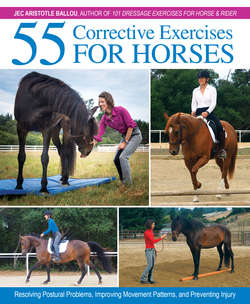Читать книгу 55 Corrective Exercises for Horses - Jec Aristotle Ballou - Страница 26
EXERCISE 12: Ride with a Lariat
Оглавление| PURPOSE: | Develops lightness, encouraging the withers to rise and the back to swing. |
A good follow-up to Exercise 4 (see p. 17) is to ride inside an arena using a lariat (also called a neck ring or rope) rather than the reins to guide your horse around. By eliminating rein stimulus and the possibility of the horse becoming rigid or bracing his jaw and neck muscles—and, therefore, leaning forward with his chest—you can develop greater lightness in his movement. By stimulating the base of the neck with your ring or rope, a reflex is triggered that encourages the withers to rise and the back to swing. Many students have reported improved results with collection after introducing some work with the lariat.
1 Place a braided rope or ring around the widest part of your horse’s neck. It should fit well enough so that it does not flop around but not so tight it pushes down into the skin (fig. 1.14 A).1.14 A: For the first few times, it’s advisable to practice riding with a lariat (or neck rope) while also using your bridle to guide the horse periodically.
2 In the beginning, ride by holding both your bridle reins and the lariat, but try to give the majority of your cues with the neck ring, not your reins.
3 If your horse is heavy-bodied or likely to ignore a lightweight neck lariat, you may find it helpful to use a thin wooden or plastic ring that can give a stronger signal as you begin this work.
4 Hold your bridle reins between your middle and ring fingers and the neck lariat under the little finger.
5 Alternatively, you may find it easier to hold the reins in one hand and the neck ring in the other. Either means of holding is acceptable.
6 Begin by asking your horse to stop and start. To stop, lift the ring half-way up the neck and apply pressure.
7 Once you can stop and start with ease, begin practicing turns. To turn the horse, use the lariat like neck-reining, pushing the side of the ring against his neck to move him away from that pressure.
8 When your horse is responding reliably to the use of the lariat, remove your bridle and continue to ride the same patterns and turns as above (fig. 1.14 B).1.14 B: Most horses catch on very quickly, but neck rope riding can be frustrating initially if the horse is accustomed to a bridle. Riders often experience pleasant surprises riding with the lariat. Among them: independent use of their seat, light and effective communication, and a different attitude or approach to work from their horse.
Obviously, you can be as creative as you wish as your aptitude with the lariat increases. For most therapeutic purposes, though, it is enough to practice turning and stop-start-stop transitions with the neck ring.
